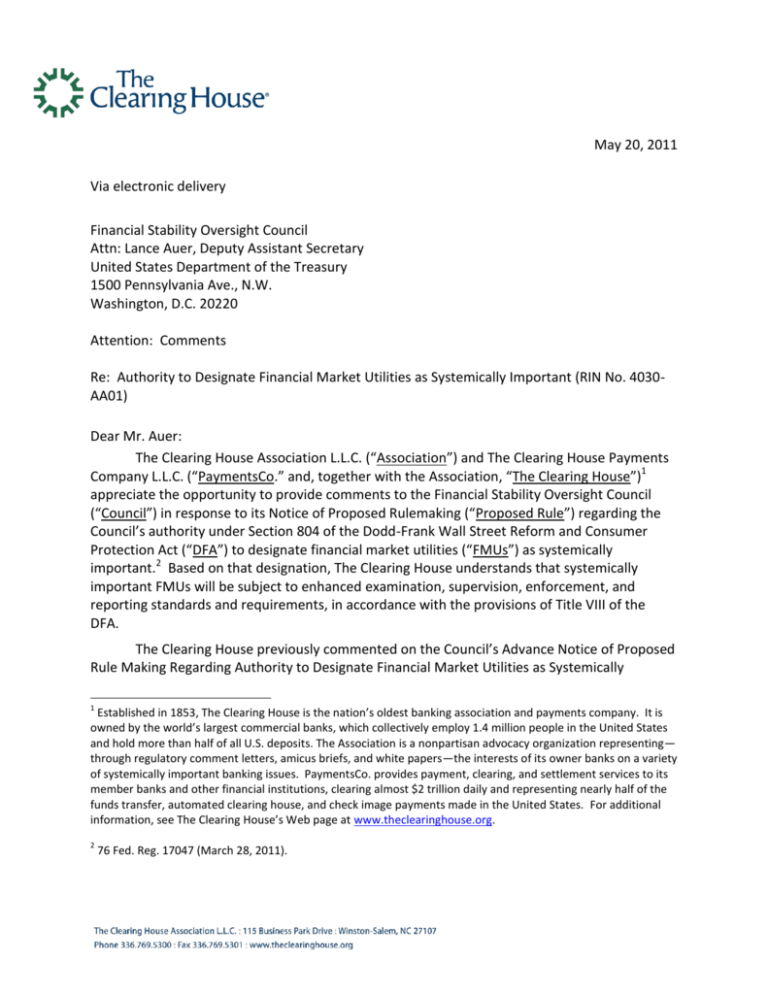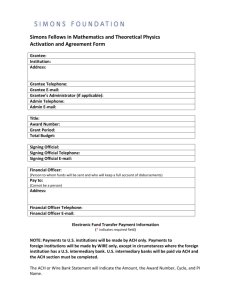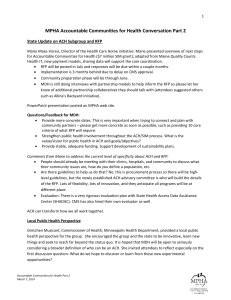the PDF
advertisement

May 20, 2011 Via electronic delivery Financial Stability Oversight Council Attn: Lance Auer, Deputy Assistant Secretary United States Department of the Treasury 1500 Pennsylvania Ave., N.W. Washington, D.C. 20220 Attention: Comments Re: Authority to Designate Financial Market Utilities as Systemically Important (RIN No. 4030AA01) Dear Mr. Auer: The Clearing House Association L.L.C. (“Association”) and The Clearing House Payments Company L.L.C. (“PaymentsCo.” and, together with the Association, “The Clearing House”)1 appreciate the opportunity to provide comments to the Financial Stability Oversight Council (“Council”) in response to its Notice of Proposed Rulemaking (“Proposed Rule”) regarding the Council’s authority under Section 804 of the Dodd-Frank Wall Street Reform and Consumer Protection Act (“DFA”) to designate financial market utilities (“FMUs”) as systemically important.2 Based on that designation, The Clearing House understands that systemically important FMUs will be subject to enhanced examination, supervision, enforcement, and reporting standards and requirements, in accordance with the provisions of Title VIII of the DFA. The Clearing House previously commented on the Council’s Advance Notice of Proposed Rule Making Regarding Authority to Designate Financial Market Utilities as Systemically 1 Established in 1853, The Clearing House is the nation’s oldest banking association and payments company. It is owned by the world’s largest commercial banks, which collectively employ 1.4 million people in the United States and hold more than half of all U.S. deposits. The Association is a nonpartisan advocacy organization representing— through regulatory comment letters, amicus briefs, and white papers—the interests of its owner banks on a variety of systemically important banking issues. PaymentsCo. provides payment, clearing, and settlement services to its member banks and other financial institutions, clearing almost $2 trillion daily and representing nearly half of the funds transfer, automated clearing house, and check image payments made in the United States. For additional information, see The Clearing House’s Web page at www.theclearinghouse.org. 2 76 Fed. Reg. 17047 (March 28, 2011). Lance Auer -2- May 20, 2011 Important (the “Advance Notice”) in January of this year, supporting the purposes of Title VIII of the DFA. The Clearing House recognizes the importance of systemically important payment systems to financial stability and continues to support the Council’s ongoing efforts, as well as the Federal Reserve Board of Governors’ (“Board”) efforts, to implement Title VIII. Responding to the Advance Notice, The Clearing House commented that only the largest interbank payment systems could “create or increase the risk of significant liquidity problems spreading among financial institutions or markets and thereby threaten the stability of the financial system of the United States,”3 and therefore that only those FMUs should be designated systemically important. The Clearing House recognizes the systemic importance of large value payment systems, such as PaymentsCo.’s Clearing House Interbank Payment System (“CHIPS”) and the Federal Reserve Banks’ Fedwire Funds Service (“Fedwire”) and Fedwire Securities Service. The Clearing House expects that CHIPS will be designated systemically important and subject to the type of risk management standards contemplated by the DFA and ultimately adopted by the Board, and that the Federal Reserve will meet or exceed any requirements imposed on the private sector payments systems in its own payment operations.4 The Clearing House also provided comment on the limited risks posed by lower-value payment systems. Specifically, The Clearing House commented that retail payments systems such as automated clearing house (“ACH”) and check clearing and settlement systems do not possess the key characteristics of systemically important payment systems. After consideration of the comments submitted in response to the Advance Notice, the Council declined to categorically exclude retail payment systems, such as the Electronic Payments Network (“EPN”), from consideration as systemically important FMUs.5 With this comment, The Clearing House is providing additional information on the limited risks presented by the clearance and settlement of ACH transactions in systems such as EPN, and the reasons why EPN should not be designated a systemically important FMU. 3 12 U.S.C. § 5462(9). 4 Failure to impose similar requirements on Federal Reserve payment systems would have a direct and material adverse effect on the private sector’s ability to compete effectively with the Federal Reserve Banks. 5 Although this letter focuses on ACH transactions that are cleared and settled by EPN, check image clearing arrangements, such as PaymentsCo.’s image clearing network (“IPN”), raise the same issues raised in this letter concerning ACH debit transaction. Moreover, IPN consists solely of returnable debit transactions and clears less than 3 percent of the dollar volume that CHIPS settles on a daily basis. Lance Auer -3- May 20, 2011 SUMMARY ACH clearance and settlement systems should not be designated systemically important FMUs. 1. The credit risk exposure of a participant in an ACH clearance and settlement system is limited for several reasons, including transaction volume, finality expectations, and participants’ internal risk management controls. In an ACH debit transaction, an originating depository financial institution’s (“ODFI”) credit risk exposure is limited to the amount that the ODFI has made available to the originator prior to learning of the settlement failure, less the amount the ODFI can recover from the originator. Because ACH debit transactions are returnable for any reason, ODFIs regularly manage this risk with respect to originators. In an ACH credit transaction, a receiving depository financial institution’s (“RDFI”) credit risk is limited to the amount that the RDFI has made available to the receiver prior to learning of the settlement failure, less the amount that the RDFI can recover from the receiver. 2. Participants’ liquidity risk exposures are low and manageable in the ordinary course of business. 3. To the extent that there is a disruption in ACH clearance and settlement that delays payments to payees, such a disruption can be addressed by payment substitutes. 4. Designating EPN as a systemically important FMU would have direct and material adverse effect on the availability of low-cost ACH transactions. DETAILED COMMENTS The Clearing House understands that the Council may wish to establish broad criteria for the designation of systemically important FMUs in order to avoid, inadvertently, establishing criteria that could preclude the Council from designating truly systemically important payment system. The Clearing House believes, however, that this risk can be avoided by carefully crafting clear criteria, which would also provide greater certainty to payment systems and payment system participants. The Clearing House further believes that providing the Council with more detailed information about the risks presented by ACH clearance and settlement through EPN may help the Council craft such criteria and develop a better understanding of the risks posed by the clearance and settlement of ACH transactions. Lance Auer -4- May 20, 2011 Participants in an ACH clearance and settlement system, such as EPN, do not have the same credit or liquidity risk exposures as participants in large-value payment systems, such as CHIPS or Fedwire. Because of the nature of ACH transactions, a settlement failure with respect to a specific dollar value of ACH transactions would not have the same consequences on a system participant as a settlement failure of the same dollar value in a large-value payment system. For these reasons, which are discussed more completely below, The Clearing House believes that it would be inappropriate for the Council to designate EPN as a systemically important FMU. 1. The credit risk exposure of a participant in an ACH clearance and settlement system is limited for several reasons, including transaction volume, finality expectations, and participants’ internal risk management controls. With respect to ACH debit transactions, an ODFI’s credit risk exposure due to the failure of an RDFI is limited to the value of the debit entries that the ODFI has made available to the originator before the ODFI receives notice of the failure (i.e., the point at which the ODFI can put a hold on the proceeds of any such debit entry). Such debit entries may include entries that are scheduled to settle after the RDFI fails. This ODFI’s credit risk is similar in magnitude, if not in probability, to the risk that an ACH debit transaction may be returned on the banking day after the settlement day essentially for any reason.6 The ODFI’s exposure, however, is mitigated because the ODFI has a claim on the originator in the amount of the returned transaction. Therefore, the ODFI has a credit exposure only to the extent that the originator does not have sufficient funds in his or her account to cover the transaction and any amount withdrawn cannot be recouped from the originator.7 With respect to ACH credit transactions, the RDFI’s credit risk exposure due to the failure of an ODFI is limited to the value of the credit entries that the RDFI has made available to the receiver before the RDFI receives notice of the failure. As with debit transactions, the RDFI’s exposure is mitigated in that it has a claim against the receiver for the amount of funds previously made available. 6 7 See NACHA Operating Rules § 3.8, available at http://www.achrulesonline.org/. An ODFI’s exposure could be further mitigated by moving settlement earlier in the day on settlement date. NACHA operating rules require funds availability at the beginning of the banking day on settlement date. See NACHA Operating Rules § 3.3.1. Similarly, Regulation CC requires, for ACH transactions, funds availability not later than the business day after the banking day on which the bank received the electronic payment. 12 C.F.R. § 229.10(b). Shifting the time of settlement to a point earlier in the day would mitigate the risk of an originator withdrawing the funds and leaving insufficient funds for the ODFI’s claim against the originator. Lance Auer -5- May 20, 2011 The extent of these credit exposures is within the range of exposures that financial institutions regularly manage with respect to their counterparties. Assuming that the largest EPN participants exchange transactions bilaterally, the largest potential exposure for an EPN participant on a peak day is $6.1 billion, and on an average day is $5.4 billion.8 Even the peak day of this inflated calculation results in an exposure that is less than one-third of the most exposed EPN participant’s unsecured lending limit.9 Thus, because of both the limited exposures in the clearance and settlement of ACH transactions and the nature of these transactions, as described above, the failure of an EPN participant to settle would not likely jeopardize the solvency of other participants. 2. Participants’ liquidity risk exposure is low and manageable in the ordinary course of business. ACH credit transactions do not carry the expectation of finality that is characteristic of other electronic payment transactions subject to Article 4A of the Uniform Commercial Code (“Article 4A”). Article 4A does not apply to “any funds transfer any part of which is governed by the Electronic Funds Transfer Act of 1978 *(the ‘EFTA’)+,” and the EFTA covers consumer transfers of funds “processed by automated clearinghouse.” Therefore, for consumer ACH credit transactions (e.g., salary and benefit payments), the bank receiving payment should have no expectation that such payments are final until settlement for the payments is actually completed. In practice, corporate customers also will not have an expectation of final payment until settlement, assuming that the corporate customer (i.e., the beneficiary), the beneficiary’s bank, and the originator’s bank agree, as is typically the case, that receiver finality does not apply in the event of a settlement failure.10 Without this expectation of finality, participants will not immediately rely on the liquidity of an ACH credit transaction to discharge other obligations outside of the ACH system. The potential for ACH debit transactions to have a systemic effect is even more remote because of originators’ and participants’ finality expectations. ACH debit transactions are returnable as a matter of right. All ACH debit transactions can be returned on the banking day 8 This calculated exposure is entirely improbable, but is provided for purpose of illustrating the extent of exposures in the ACH system. We performed this calculation for the peak day in April 2011 and the average day during the same period. The bilateral exchange is between Financial Institution A, the largest receiver of debit transactions, and Financial Institution B, the largest receiver of credit transactions. The calculation assumes that Financial Institution B receives all of its ACH credit transactions from Financial Institution A and originates all of its ACH debit transactions to Financial Institution B. As such, Financial Institution B would have the largest possible credit exposure to Financial Institution A. 9 12 C.F.R. § 32.3(a) (permitting unsecured lending up to 15 percent of a national bank’s capital and surplus). UCC § 4A-405(d). 10 Lance Auer -6- May 20, 2011 after the settlement day essentially for any reason. Disputed consumer debit entries can be returned for an extended period. These finality principles are well understood by originators and ACH system participants. Given the uncertain, and in some cases provisional, nature of settlement of ACH transactions, banks cannot rely on these funds as assured sources of liquidity. Further, as noted above, in connection with credit risk, the liquidity exposures between ODFIs and RDFIs are relatively low and the liquidity risks of participating in EPN or other low-value payment systems are well within the level of liquidity risk that participants regularly manage in the ordinary course of business. We further note that the designation of an ACH system that does not assume credit or liquidity risks in the first place does not serve the purposes of Title VIII. Participants in the ACH system expect to manage their own credit and liquidity risks. Where these participant risks are within the range of risks that banks manage for other liquidity purposes,11 there is no reason to shift these risks to the payment system. As noted above, since daily credit and liquidity exposures between counterparties in a payment system such as EPN are on the order of magnitude that may arise from counterparties elsewhere, such as loans, it is both reasonable to expect the system participants to manage those risks, and unreasonable to require the payment system to manage those risks.12 3. To the extent that there is a disruption in ACH clearance and settlement that delays payments to payees, such a disruption can be addressed by payment substitutes. Disruption of ACH clearance and settlement does not hold the potential to lead to the type of systemic event contemplated by the DFA, although it may force counterparties to find other means of discharging payment obligations. This inconvenience should not be confused with a loss of confidence in financial institutions and a refusal to deal between financial institutions, which The Clearing House believes are the hallmarks of systemic events. Employers, consumers, and merchants will still be able to meet their payment obligations through accounts at other financial institutions or through other retail payment alternatives. In the event of either a failure of an EPN participant or an operational disruption, we also note that retail payment systems are readily substitutable, typically with only minimal delay. For higher-priority payments, counterparties can use Fedwire or CHIPS. For lower11 12 See, e.g., 12 U.S.C. § 84(a) (describing national bank lending limits). While the liquidity risk on a failed payment is similar to the liquidity risk on a failed loan repayment, the credit risk on the payment is inherently less to the extent that the bank receiving the payment retains the right to recoup any funds made available to the payee from the payee, as is typically the case with respect to ACH payments. Lance Auer -7- May 20, 2011 priority payments, counterparties can use the other ACH operator, checks, and other retail payment alternatives. In addition, the risk of operational disruption is adequately addressed through the existing supervisory mechanism, including under the Bank Services Companies Act, and does not require creating a new layer of regulation under Title VIII. 4. Designating EPN as a systemically important FMU would have a direct and material adverse effect on the availability of low-cost ACH transactions. As discussed above and in The Clearing House’s comment letter responding to the Advance Notice, ACH transactions do not carry an expectation of finality. This expectation is consistent with the fundamental purpose of ACH clearance and settlement: to provide a lowercost method of making relatively small dollar payments. To accomplish this purpose, settlement for ACH transactions has always been based on recasting the settlement, and deleting those transactions that cannot be settled. This type of unwind is a fundamental part of settlement for the ACH networks, including EPN and the Federal Reserve Banks’ FedACH Service (“FedACH”). These ACH networks remove a defaulting participant’s transactions in the event that the defaulting participant has insufficient funds to settle all of the transactions. 13 This settlement practice helps the ACH networks to provide affordable retail payments to merchants and consumers, and the risk of unwinding payments is well understood by participants in the ACH networks. Prohibiting ACH clearance and settlement systems from unwinding transactions would require fundamental changes to the ACH settlement process and would significantly change the nature of ACH transactions themselves. Changing the nature of ACH transactions to provide for same-day finality would encourage the use of the ACH for large dollar value transactions and lead to other changes in security and controls that would fundamentally change the nature of the ACH system and significantly increase the cost of processing small dollar value transactions through the ACH. Such a cost increase could provide an incentive for participants to return to less efficient paper-based payments, particularly in the case of ACH check conversion transactions, which are growing in volume, or to use other lower-cost alternatives that may not provide participants the same risk management controls. For the reasons described above and in The Clearing House’s earlier correspondence with the Council, The Clearing House does not believe ACH clearance and settlement systems, including EPN, should be designated as systemically important. 13 See Federal Reserve Bank Operating Circular 4, § 11.1, available at http://frbservices.org/files/regulations/pdf/operating_circular_4_010111.pdf; see also EPN Rules, § 7.7.5.3, available at http://www.epaynetwork.com/cms/documents/001748.pdf. Lance Auer -8- May 20, 2011 ***** Thank you for your consideration and review of our comments. If you have any questions or wish to discuss The Clearing House’s comments, please do not hesitate to contact me at (336) 769-5314. Yours very truly, Robert C. Hunter Deputy General Counsel




